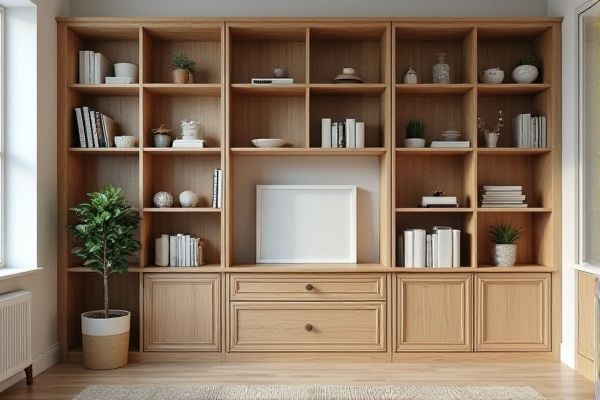
Cube storage offers a versatile and visually appealing solution ideal for organizing items in modular compartments, while cabinet storage provides a more enclosed, secure option to keep belongings concealed and protected from dust. Explore the detailed comparison to discover which storage method best suits your space and organizational needs.
Table of Comparison
| Feature | Cube Storage | Cabinet Storage |
|---|---|---|
| Design | Open, modular cubes | Enclosed compartments with doors |
| Accessibility | Easy, visible access | Protected, hidden access |
| Storage Type | Books, decor, small items | Bulkier items, sensitive valuables |
| Customization | Flexible, stackable units | Fixed or adjustable shelves |
| Space Usage | Optimal for open display | Maximized for concealed storage |
| Material | Wood, metal, plastic | Wood, MDF, metal |
| Cost | Generally affordable | Varies, often higher |
| Ideal For | Living rooms, offices | Kitchens, storage rooms, offices |
Overview of Cube Storage vs Cabinet Storage
Cube storage offers modular, open compartments ideal for displaying items and optimizing small spaces, often made from lightweight materials like wood or plastic. Cabinet storage provides enclosed sections with doors or drawers, enhancing security and protection from dust, typically crafted from solid wood or metal for durability. Choice depends on the need for visibility and accessibility versus concealment and organized separation.
Design and Aesthetic Differences
Cube storage features an open, modular design offering versatile visual appeal and easy access, ideal for showcasing decor or organizing items with a minimalist look. Cabinet storage provides a more traditional, enclosed design that conceals clutter, creating a sleek and polished aesthetic suited for a refined, cohesive room style. Your choice depends on whether you prefer the airy transparency of cubes or the structured elegance of cabinets.
Storage Capacity Comparison
Cube storage units typically offer larger, more versatile storage capacity ideal for organizing bulky items or multiple smaller objects in designated compartments. Cabinet storage usually provides enclosed spaces with adjustable shelves that maximize vertical space for storing items securely and protected from dust. Comparing storage capacity depends on specific dimensions and use cases, but cubes excel in modular flexibility while cabinets prioritize enclosed, stackable storage efficiency.
Space Utilization & Flexibility
Cube storage maximizes space utilization by offering open compartments that can be customized with bins, baskets, or drawers, making it ideal for versatile organization. Cabinet storage provides enclosed spaces that protect items from dust and create a tidy appearance but may limit flexibility due to fixed shelving. Your choice between cube and cabinet storage depends on whether you prioritize adaptable space arrangements or secure, concealed storage.
Organizational Options and Accessibility
Cube storage offers modular compartments that allow you to customize organization for items of varying sizes, making it ideal for flexible storage solutions. Cabinet storage features enclosed spaces with doors or drawers, providing a more polished look while protecting contents from dust but potentially limiting quick access. Your choice depends on whether you prioritize visible, easy access or concealed, structured organization in your space.
Durability and Material Choices
Cube storage units often feature sturdy materials like engineered wood and fabric bins, offering moderate durability ideal for lightweight to medium items. Cabinet storage typically uses solid wood, metal, or high-quality MDF, providing enhanced durability and protection for your belongings in high-traffic areas. Your choice depends on the required strength and longevity, with cabinets excelling in robustness and cube storage offering versatile, lightweight options.
Cost Considerations
Cube storage units generally offer a more affordable and versatile option for organizing spaces compared to traditional cabinet storage, as they often require less material and simpler construction. Cabinets, while typically more expensive due to their solid wood or custom-built designs, provide enhanced durability and a polished aesthetic, which can justify the higher cost in certain settings. When budgeting, it is important to weigh the initial purchase price against long-term benefits such as maintenance, customization, and space efficiency.
Ease of Assembly and Installation
Cube storage units typically offer straightforward assembly with modular, stackable components that require minimal tools, making them ideal for quick setup in various spaces. Cabinet storage often involves more complex installation due to built-in hinges, doors, and hardware, which may require precise alignment and additional tools. The simplicity of cube storage ensures faster assembly, while cabinet storage provides a more permanent and finished look but demands more installation effort.
Maintenance and Cleaning Requirements
Cube storage units typically require less maintenance and are easier to clean due to their open design, allowing you to quickly dust and wipe surfaces. Cabinet storage often involves more upkeep because enclosed spaces can trap dust and require regular interior cleaning to prevent buildup. Your choice should consider how much time you want to spend on maintenance and cleaning to keep your space organized and tidy.
Best Use Cases for Cube and Cabinet Storage
Cube storage units excel in organizing small to medium-sized items, making them ideal for books, toys, and decorative pieces in living rooms, offices, and kids' rooms. Cabinet storage offers enclosed compartments suitable for hiding clutter, securing valuables, and storing items that require dust protection, perfect for kitchens, bathrooms, and professional settings. Both storage types optimize space utilization, but cube storage prioritizes accessibility and display, while cabinet storage emphasizes concealment and organization.
 homyna.com
homyna.com